Reason to Believe 9
Chris Knepp
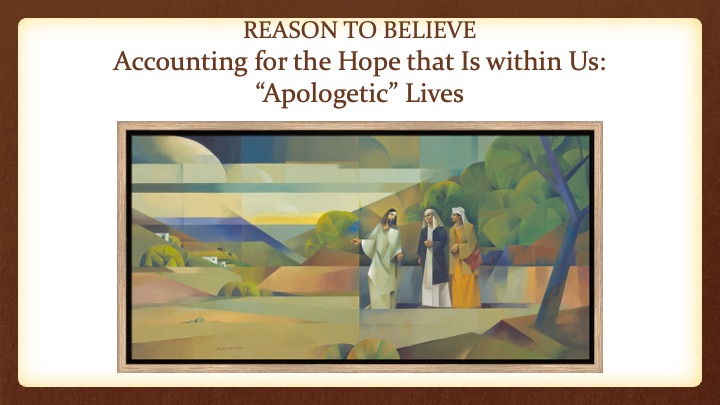
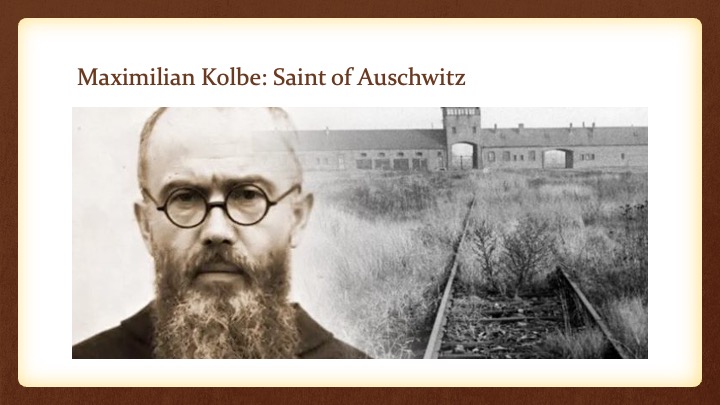
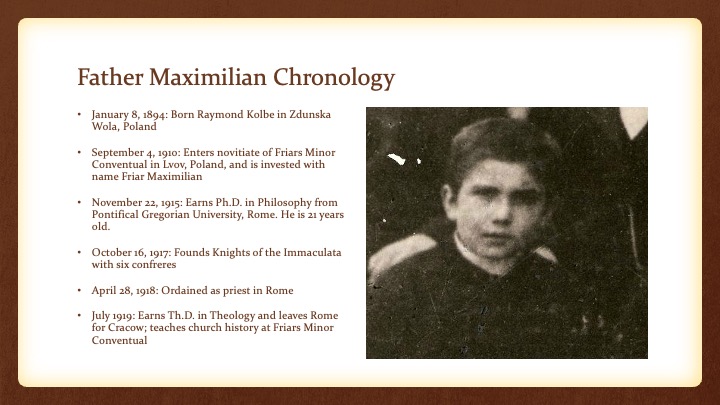
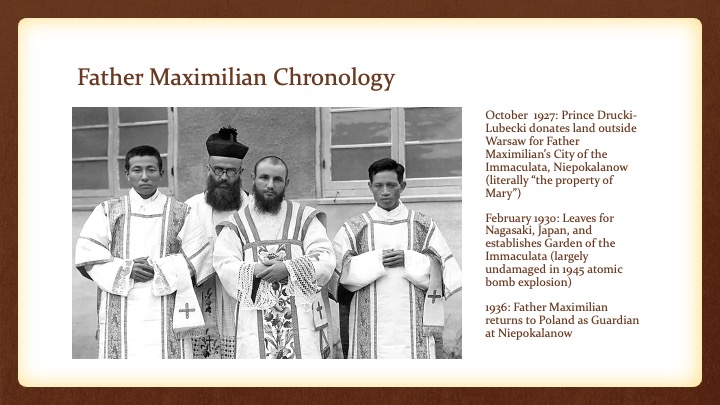
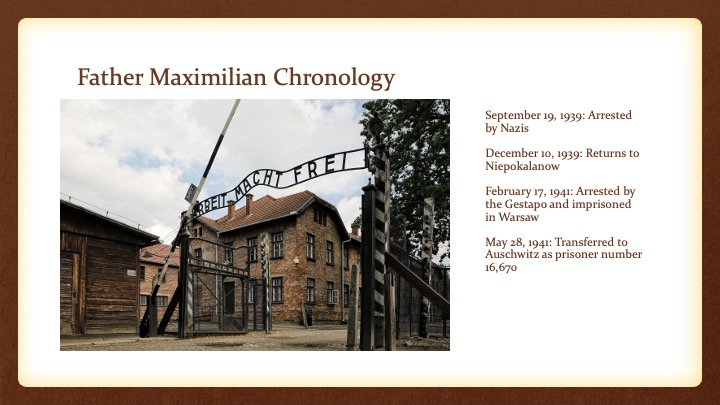
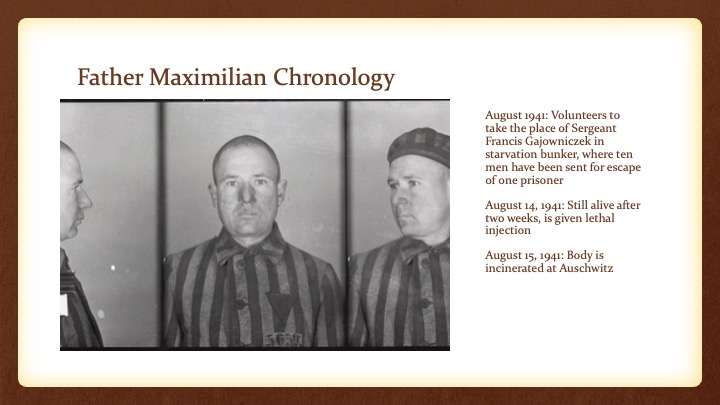
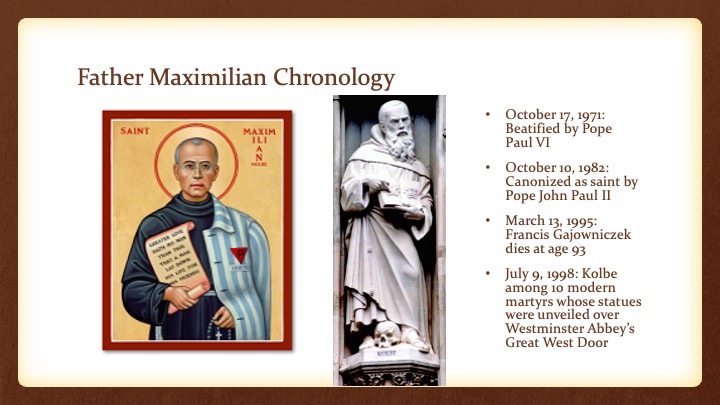
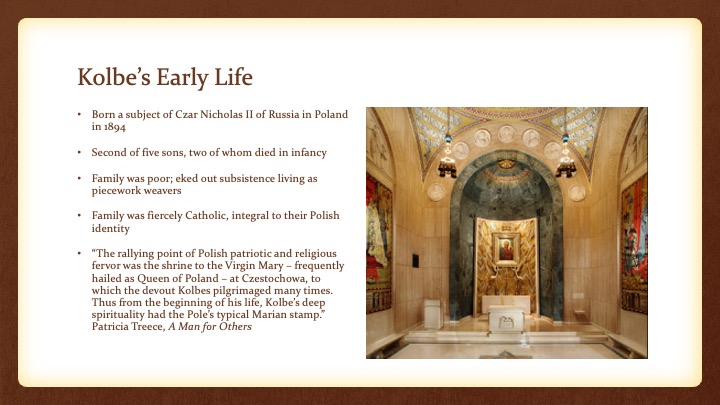
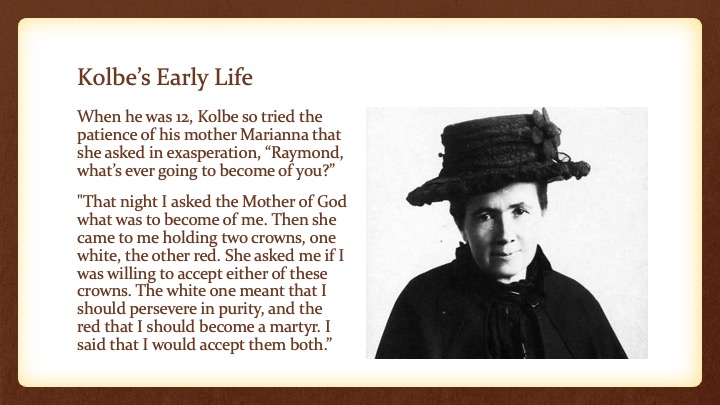
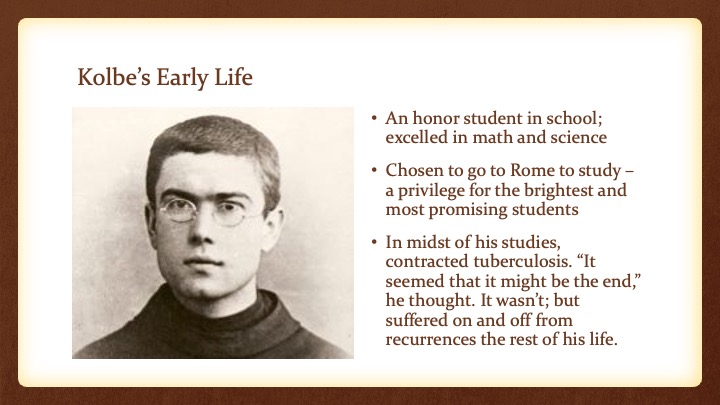

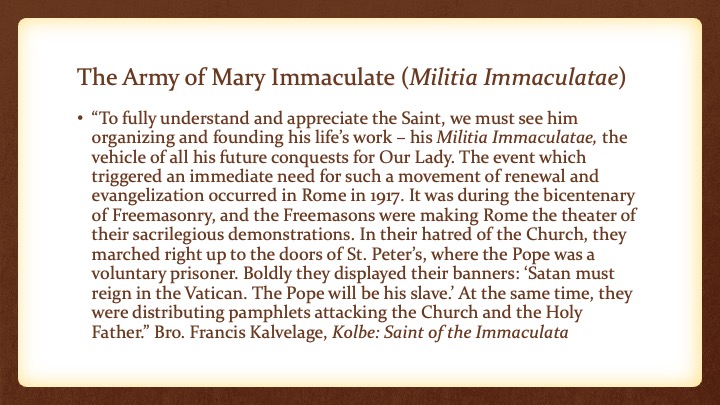
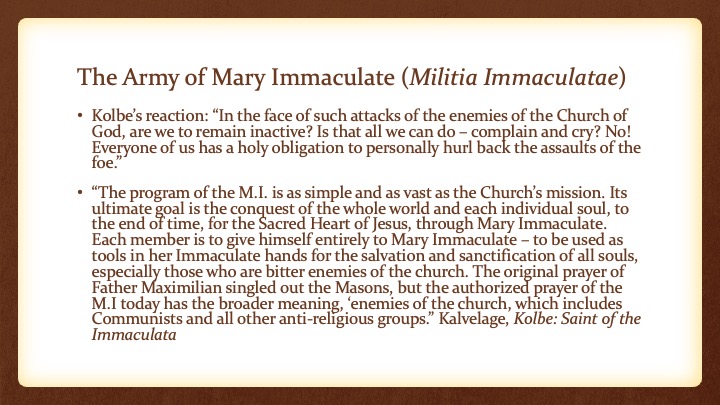
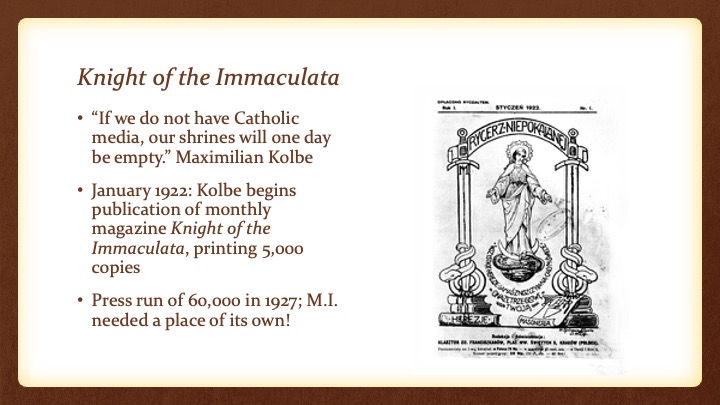

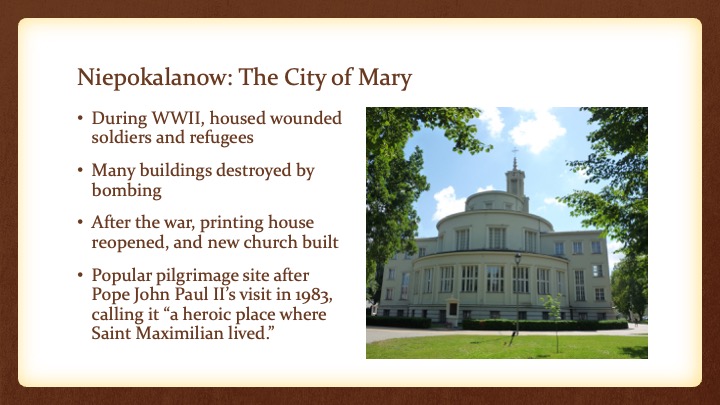
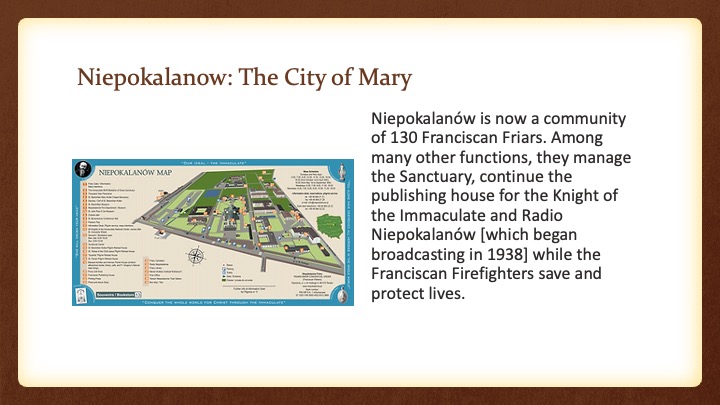
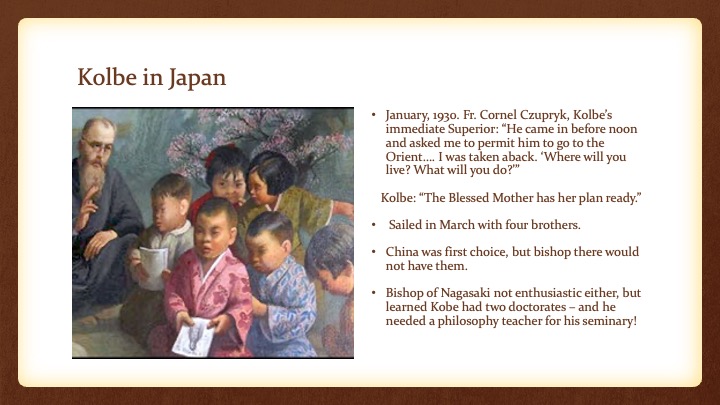
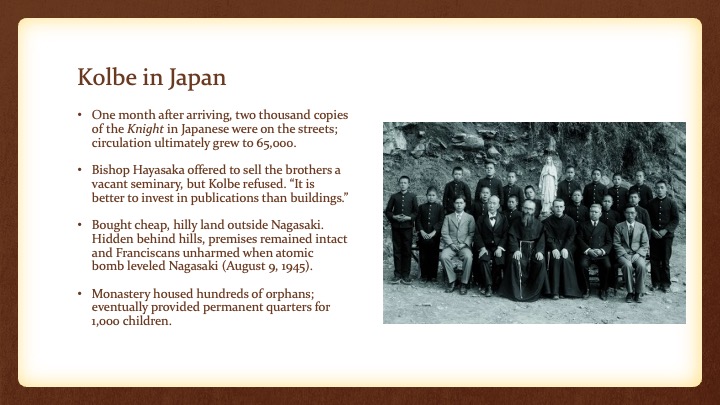

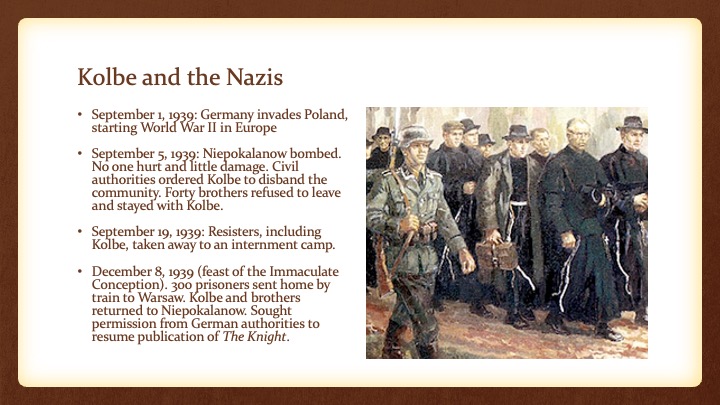
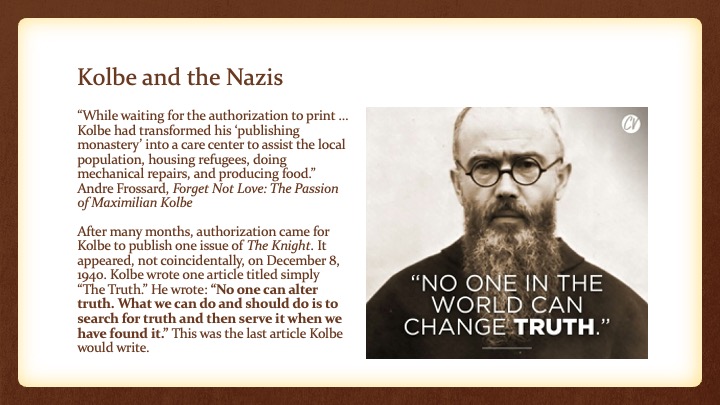

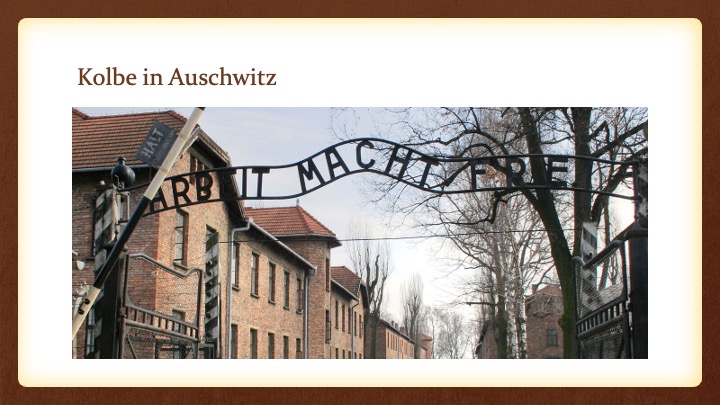
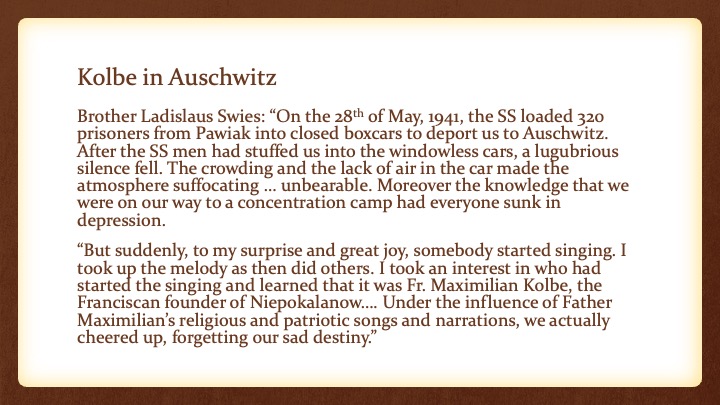

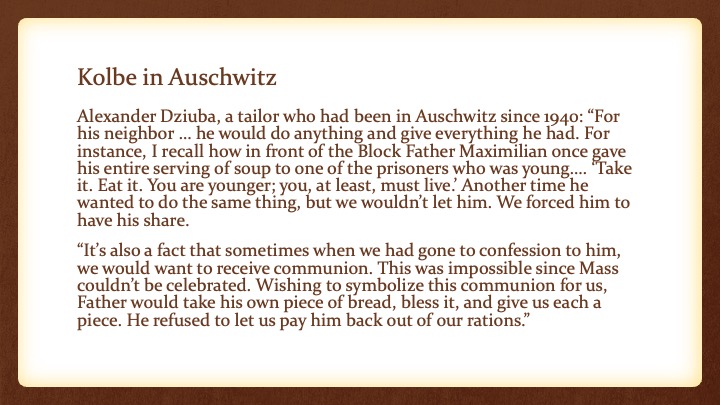
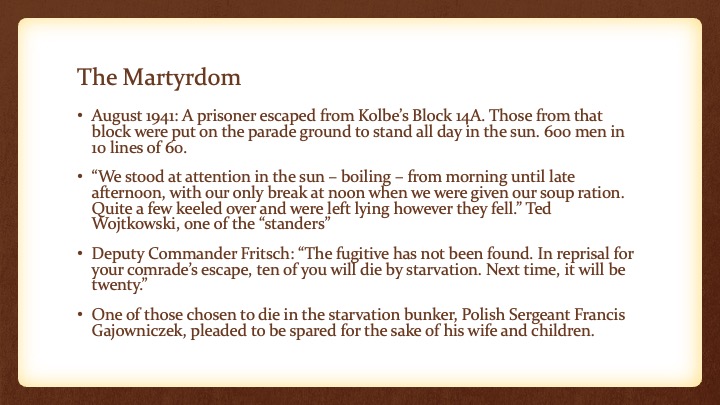
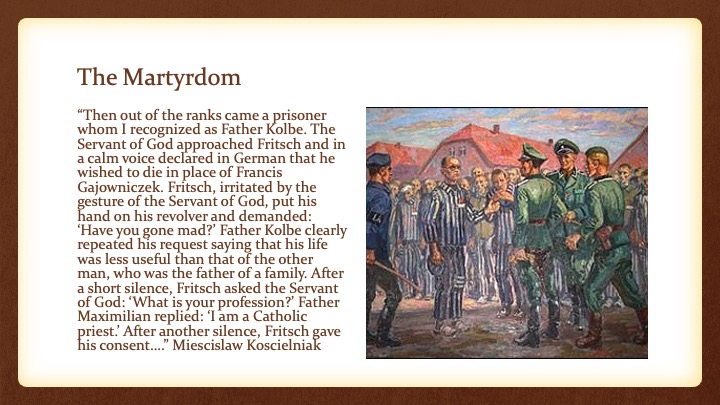
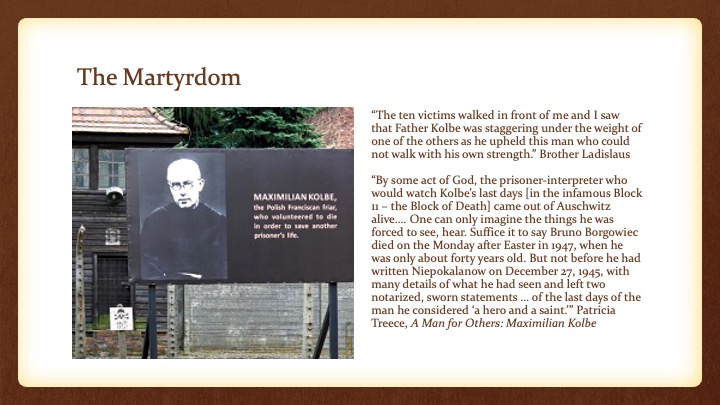
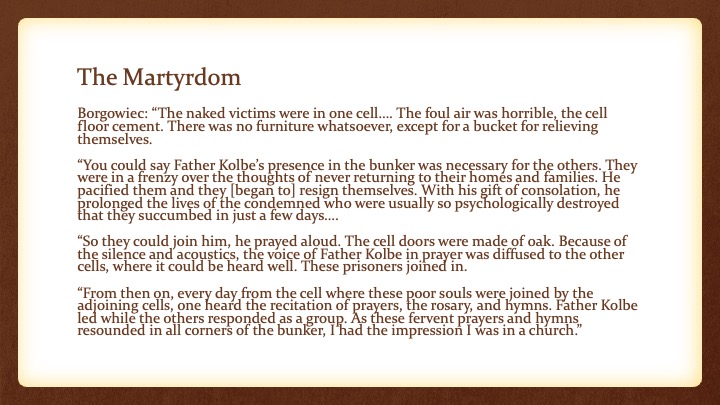
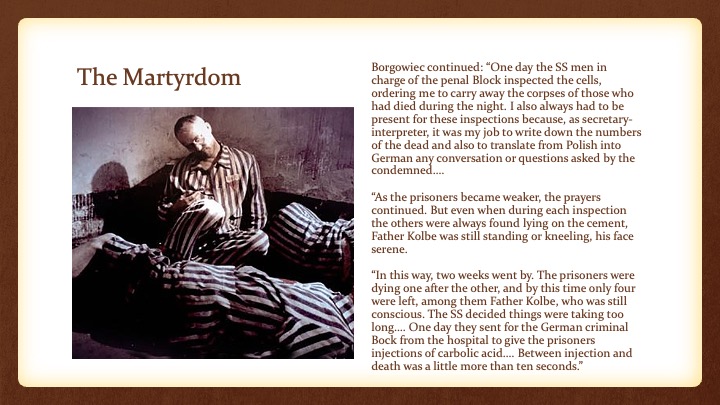
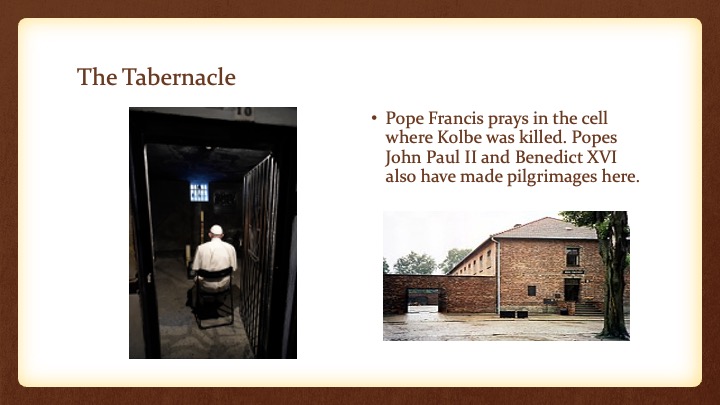
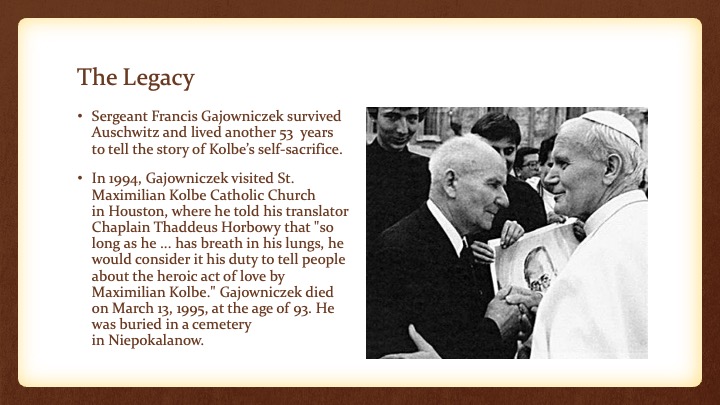
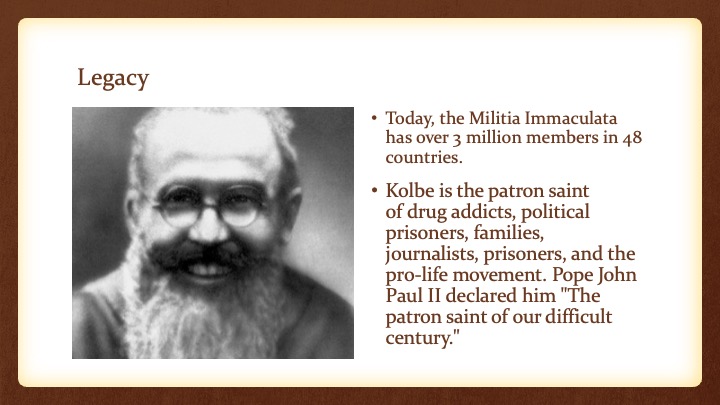
Reason to Believe 9
Links
< Home Page > < Reason to Believe Menu >
Reason to Believe 9 – The Text
REASON TO BELIEVE
Accounting for the Hope that Is within Us:
“Apologetic” Lives
Maximilian Kolbe: Saint of Auschwitz
Father Maximilian Chronology
• January 8, 1894: Born Raymond Kolbe in Zdunska Wola, Poland
• September 4, 1910: Enters novitiate of Friars Minor Conventual in Lvov, Poland, and is invested with name Friar Maximilian
• November 22, 1915: Earns Ph.D. in Philosophy from Pontifical Gregorian University, Rome. He is 21 years old.
• October 16, 1917: Founds Knights of the Immaculata with six confreres
• April 28, 1918: Ordained as priest in Rome
• July 1919: Earns Th.D. in Theology and leaves Rome for Cracow; teaches church history at Friars Minor Conventual
• October 1927: Prince Drucki-Lubecki donates land outside Warsaw for Father Maximilian’s City of the Immaculata, Niepokalanow (literally “the property of Mary”)
• February 1930: Leaves for Nagasaki, Japan, and establishes Garden of the Immaculata (largely undamaged in 1945 atomic bomb explosion)
• 1936: Father Maximilian returns to Poland as Guardian at Niepokalanow
• September 19, 1939: Arrested by Nazis
• December 10, 1939: Returns to Niepokalanow
• February 17, 1941: Arrested by the Gestapo and imprisoned in Warsaw
• May 28, 1941: Transferred to Auschwitz as prisoner number 16,670
• August 1941: Volunteers to take the place of Sergeant Francis Gajowniczek in starvation bunker, where ten men have been sent for escape of one prisoner
• August 14, 1941: Still alive after two weeks, is given lethal injection
• August 15, 1941: Body is incinerated at Auschwitz
• October 17, 1971: Beatified by Pope Paul VI
• October 10, 1982: Canonized as saint by Pope John Paul II
• March 13, 1995: Francis Gajowniczek dies at age 93
• July 9, 1998: Kolbe among 10 modern martyrs whose statues were unveiled over Westminster Abbey’s Great West Door
Kolbe’s Early Life
• Born a subject of Czar Nicholas II of Russia in Poland in 1894
• Second of five sons, two of whom died in infancy
• Family was poor; eked out subsistence living as piecework weavers
• Family was fiercely Catholic, integral to their Polish identity
• “The rallying point of Polish patriotic and religious fervor was the shrine to the Virgin Mary – frequently hailed as Queen of Poland – at Czestochowa, to which the devout Kolbes pilgrimaged many times. Thus from the beginning of his life, Kolbe’s deep spirituality had the Pole’s typical Marian stamp.” Patricia Treece, A Man for Others
• When he was 12, Kolbe so tried the patience of his mother Marianna that she asked in exasperation, “Raymond, what’s ever going to become of you?”
• "That night I asked the Mother of God what was to become of me. Then she came to me holding two crowns, one white, the other red. She asked me if I was willing to accept either of these crowns. The white one meant that I should persevere in purity, and the red that I should become a martyr. I said that I would accept them both.”
• An honor student in school; excelled in math and science
• Chosen to go to Rome to study – a privilege for the brightest and most promising students
• In midst of his studies, contracted tuberculosis. “It seemed that it might be the end,” he thought. It wasn’t; but suffered on and off from recurrences the rest of his life.
The Army of Mary Immaculate (Militia Immaculatae)
• At low point of his physical health, began recruiting members for a spiritual Militia
• Purpose was to fight for God under Mary’s leadership
• Founded October 16, 1917 (three days after the final apparition of Mary at Fatima and the Miracle of the Sun)
• Composed mostly of Kolbe’s closest friends (“the seven saintly founders,” Kolbe called them), two of whom died in 1918 flu epidemic
• “To fully understand and appreciate the Saint, we must see him organizing and founding his life’s work – his Militia Immaculatae, the vehicle of all his future conquests for Our Lady. The event which triggered an immediate need for such a movement of renewal and evangelization occurred in Rome in 1917. It was during the bicentenary of Freemasonry, and the Freemasons were making Rome the theater of their sacrilegious demonstrations. In their hatred of the Church, they marched right up to the doors of St. Peter’s, where the Pope was a voluntary prisoner. Boldly they displayed their banners: ‘Satan must reign in the Vatican. The Pope will be his slave.’ At the same time, they were distributing pamphlets attacking the Church and the Holy Father.” Bro. Francis Kalvelage, Kolbe: Saint of the Immaculata
• Kolbe’s reaction: “In the face of such attacks of the enemies of the Church of God, are we to remain inactive? Is that all we can do – complain and cry? No! Everyone of us has a holy obligation to personally hurl back the assaults of the foe.”
• “The program of the M.I. is as simple and as vast as the Church’s mission. Its ultimate goal is the conquest of the whole world and each individual soul, to the end of time, for the Sacred Heart of Jesus, through Mary Immaculate. Each member is to give himself entirely to Mary Immaculate – to be used as tools in her Immaculate hands for the salvation and sanctification of all souls, especially those who are bitter enemies of the church. The original prayer of Father Maximilian singled out the Masons, but the authorized prayer of the M.I today has the broader meaning, ‘enemies of the church, which includes Communists and all other anti-religious groups.” Kalvelage, Kolbe: Saint of the Immaculata
Knight of the Immaculata
• “If we do not have Catholic media, our shrines will one day be empty.” Maximilian Kolbe
• January 1922: Kolbe begins publication of monthly magazine Knight of the Immaculata, printing 5,000 copies
• Press run of 60,000 in 1927; M.I. needed a place of its own!
Niepokalanow: The City of Mary
• Ideal location would be near Warsaw and principal railroad lines
• Prince John Drucki-Lubecki donated tract of property large enough for expansion, 25 miles from Warsaw
• Magazine could reach many more Poles and city could develop as international center to send missionaries throughout the world
• By 1939, world’s largest monastery, housing 760 men
• Press run of Knight of the Immaculata up to 750,00 a month.
• Included a sawmill, carpentry, dairy, and repair shop for machinery
• Friars grew own food and maintained livestock, chickens, and beehives
• During WWII, housed wounded soldiers and refugees
• Many buildings destroyed by bombing
• After the war, printing house reopened, and new church built
• Popular pilgrimage site after Pope John Paul II’s visit in 1983, calling it “a heroic place where Saint Maximilian lived.”
• Niepokalanów is now a community of 130 Franciscan Friars. Among many other functions, they manage the Sanctuary, continue the publishing house for the Knight of the Immaculate and Radio Niepokalanów [which began broadcasting in 1938] while the Franciscan Firefighters save and protect lives.
Kolbe in Japan
• January, 1930. Fr. Cornel Czupryk, Kolbe’s immediate Superior: “He came in before noon and asked me to permit him to go to the Orient…. I was taken aback. ‘Where will you live? What will you do?’”
Kolbe: “The Blessed Mother has her plan ready.”
• Sailed in March with four brothers.
• China was first choice, but bishop there would not have them.
• Bishop of Nagasaki not enthusiastic either, but learned Kobe had two doctorates – and he needed a philosophy teacher for his seminary!
Kolbe in Japan
• One month after arriving, two thousand copies of the Knight in Japanese were on the streets; circulation ultimately grew to 65,000.
• Bishop Hayasaka offered to sell the brothers a vacant seminary, but Kolbe refused. “It is better to invest in publications than buildings.”
• Bought cheap, hilly land outside Nagasaki. Hidden behind hills, premises remained intact and Franciscans unharmed when atomic bomb leveled Nagasaki (August 9, 1945).
• Monastery housed hundreds of orphans; eventually provided permanent quarters for 1,000 children.
Kolbe in India
• Kolbe envisioned three Niepokalanows: Poland, Japan, and India
• July, 1932: Traveled to India and was offered land, a house, and chapel. Monastery there did not materialize, however.
• Due to poor health, Kolbe curtailed missionary work and returned to Poland in 1936. Elected Superior of Niepokalanow.
Kolbe and the Nazis
• September 1, 1939: Germany invades Poland, starting World War II in Europe
• September 5, 1939: Niepokalanow bombed. No one hurt and little damage. Civil authorities ordered Kolbe to disband the community. Forty brothers refused to leave and stayed with Kolbe.
• September 19, 1939: Resisters, including Kolbe, taken away to an internment camp.
• December 8, 1939 (feast of the Immaculate Conception). 300 prisoners sent home by train to Warsaw. Kolbe and brothers returned to Niepokalanow. Sought permission from German authorities to resume publication of The Knight.
• “While waiting for the authorization to print … Kolbe had transformed his ‘publishing monastery’ into a care center to assist the local population, housing refugees, doing mechanical repairs, and producing food.” Andre Frossard, Forget Not Love: The Passion of Maximilian Kolbe
• After many months, authorization came for Kolbe to publish one issue of The Knight. It appeared, not coincidentally, on December 8, 1940. Kolbe wrote one article titled simply “The Truth.” He wrote: “No one can alter truth. What we can do and should do is to search for truth and then serve it when we have found it.” This was the last article Kolbe would write.
• “In Kolbe’s case, he was not only a priest and leader of the Franciscans, but an opinion-molder and member of the Polish intelligentsia as the leader and the spirit behind the greatest publishing center in Poland. Just as they cried out against the anti-Church policies of Communist Russia, Niepokalanow’s publications had deplored Hitler’s anti-Church and conquest policies. The Nazis ignored the fact that Kolbe himself had never written on anything but spiritual matters, leaving politics in his publications to lay people. The fact that he was not pro-Hitler and had remarkable power to influence others was more than enough in 1941.” Patricia Treece, A Man for Others: Maximilian Kolbe
• February 17, 1941: Kolbe arrested by the Gestapo after they obtained by stealth a signed statement of treasonous activity. Taken to Warsaw’s Pawiak prison.
Kolbe in Auschwitz
Brother Ladislaus Swies: “On the 28th of May, 1941, the SS loaded 320 prisoners from Pawiak into closed boxcars to deport us to Auschwitz. After the SS men had stuffed us into the windowless cars, a lugubrious silence fell. The crowding and the lack of air in the car made the atmosphere suffocating … unbearable. Moreover the knowledge that we were on our way to a concentration camp had everyone sunk in depression.
“But suddenly, to my surprise and great joy, somebody started singing. I took up the melody as then did others. I took an interest in who had started the singing and learned that it was Fr. Maximilian Kolbe, the Franciscan founder of Niepokalanow…. Under the influence of Father Maximilian’s religious and patriotic songs and narrations, we actually cheered up, forgetting our sad destiny.”
From a prisoner who had been in Auschwitz since 1940: “From mouth to mouth passed the words, ‘Fr. Maximilian Kolbe is among us.’ Men shook their heads, ‘Even him! How cruel those Nazis are.’ And we wondered what dire things were going on in Poland. At the same time, we were glad to have such a real man, a fighter – a fighter for truth – with us.”
From another Auschwitz survivor: “From the first time I saw Father Maximilian I was struck by his dignity and calm, so different from others. In spite of the terrible conditions and bad treatment, he never complained nor did he curse. Instead he tried to comfort the other prisoners and lift our spirits.”
Fr. Conrad Szweda, a 24-year-old pastor who survived Auschwitz: “One day was especially dreadful for Kolbe. The bloody capo [head of a work squad] selected him to be the day’s special victim and tortured him as a bird of prey would a hapless mouse. Krott [the capo] himself loaded Father Maximilian’s back with the heaviest branches [they were digging out trunks and cutting trees], then ordered him to run. When the priest fell, Krott kicked him mercilessly in the face and stomach…. He ordered Kolbe to lie across a stump. Then from among the guards Krott summoned the strongest and ordered them to give the innocent priest fifty lashes.
“Afterwards Father Kolbe couldn’t even move. So Krott threw him into the mud and threw the branches on top of him. When it was time to march back to the camp, Father Maximilian was still in such a state that others had to carry him. The next day he was taken to the camp hospital.”
Alexander Dziuba, a tailor who had been in Auschwitz since 1940: “For his neighbor … he would do anything and give everything he had. For instance, I recall how in front of the Block Father Maximilian once gave his entire serving of soup to one of the prisoners who was young…. ‘Take it. Eat it. You are younger; you, at least, must live.’ Another time he wanted to do the same thing, but we wouldn’t let him. We forced him to have his share.
“It’s also a fact that sometimes when we had gone to confession to him, we would want to receive communion. This was impossible since Mass couldn’t be celebrated. Wishing to symbolize this communion for us, Father would take his own piece of bread, bless it, and give us each a piece. He refused to let us pay him back out of our rations.”
The Martyrdom
• August 1941: A prisoner escaped from Kolbe’s Block 14A. Those from that block were put on the parade ground to stand all day in the sun. 600 men in 10 lines of 60.
• “We stood at attention in the sun – boiling – from morning until late afternoon, with our only break at noon when we were given our soup ration. Quite a few keeled over and were left lying however they fell.” Ted Wojtkowski, one of the “standers”
• Deputy Commander Fritsch: “The fugitive has not been found. In reprisal for your comrade’s escape, ten of you will die by starvation. Next time, it will be twenty.”
• One of those chosen to die in the starvation bunker, Polish Sergeant Francis Gajowniczek, pleaded to be spared for the sake of his wife and children.
• “Then out of the ranks came a prisoner whom I recognized as Father Kolbe. The Servant of God approached Fritsch and in a calm voice declared in German that he wished to die in place of Francis Gajowniczek. Fritsch, irritated by the gesture of the Servant of God, put his hand on his revolver and demanded: ‘Have you gone mad?’ Father Kolbe clearly repeated his request saying that his life was less useful than that of the other man, who was the father of a family. After a short silence, Fritsch asked the Servant of God: ‘What is your profession?’ Father Maximilian replied: ‘I am a Catholic priest.’ After another silence, Fritsch gave his consent….” Miescislaw Koscielniak
• “The ten victims walked in front of me and I saw that Father Kolbe was staggering under the weight of one of the others as he upheld this man who could not walk with his own strength.” Brother Ladislaus
• “By some act of God, the prisoner-interpreter who would watch Kolbe’s last days [in the infamous Block 11 – the Block of Death] came out of Auschwitz alive…. One can only imagine the things he was forced to see, hear. Suffice it to say Bruno Borgowiec died on the Monday after Easter in 1947, when he was only about forty years old. But not before he had written Niepokalanow on December 27, 1945, with many details of what he had seen and left two notarized, sworn statements … of the last days of the man he considered ‘a hero and a saint.’” Patricia Treece, A Man for Others: Maximilian Kolbe
• Borgowiec: “The naked victims were in one cell…. The foul air was horrible, the cell floor cement. There was no furniture whatsoever, except for a bucket for relieving themselves.
• “You could say Father Kolbe’s presence in the bunker was necessary for the others. They were in a frenzy over the thoughts of never returning to their homes and families. He pacified them and they [began to] resign themselves. With his gift of consolation, he prolonged the lives of the condemned who were usually so psychologically destroyed that they succumbed in just a few days….
• “So they could join him, he prayed aloud. The cell doors were made of oak. Because of the silence and acoustics, the voice of Father Kolbe in prayer was diffused to the other cells, where it could be heard well. These prisoners joined in.
• “From then on, every day from the cell where these poor souls were joined by the adjoining cells, one heard the recitation of prayers, the rosary, and hymns. Father Kolbe led while the others responded as a group. As these fervent prayers and hymns resounded in all corners of the bunker, I had the impression I was in a church.”
• Borgowiec continued: “One day the SS men in charge of the penal Block inspected the cells, ordering me to carry away the corpses of those who had died during the night. I also always had to be present for these inspections because, as secretary-interpreter, it was my job to write down the numbers of the dead and also to translate from Polish into German any conversation or questions asked by the condemned….
• “As the prisoners became weaker, the prayers continued. But even when during each inspection the others were always found lying on the cement, Father Kolbe was still standing or kneeling, his face serene.
• “In this way, two weeks went by. The prisoners were dying one after the other, and by this time only four were left, among them Father Kolbe, who was still conscious. The SS decided things were taking too long…. One day they sent for the German criminal Bock from the hospital to give the prisoners injections of carbolic acid…. Between injection and death was a little more than ten seconds.”
The Tabernacle
• Pope Francis prays in the cell where Kolbe was killed. Popes John Paul II and Benedict XVI also have made pilgrimages here.
The Legacy
• Sergeant Francis Gajowniczek survived Auschwitz and lived another 53 years to tell the story of Kolbe’s self-sacrifice.
• In 1994, Gajowniczek visited St. Maximilian Kolbe Catholic Church in Houston, where he told his translator Chaplain Thaddeus Horbowy that "so long as he ... has breath in his lungs, he would consider it his duty to tell people about the heroic act of love by Maximilian Kolbe." Gajowniczek died on March 13, 1995, at the age of 93. He was buried in a cemetery in Niepokalanow.
Legacy
• Today, the Militia Immaculata has over 3 million members in 48 countries.
• Kolbe is the patron saint of drug addicts, political prisoners, families, journalists, prisoners, and the pro-life movement. Pope John Paul II declared him "The patron saint of our difficult century."